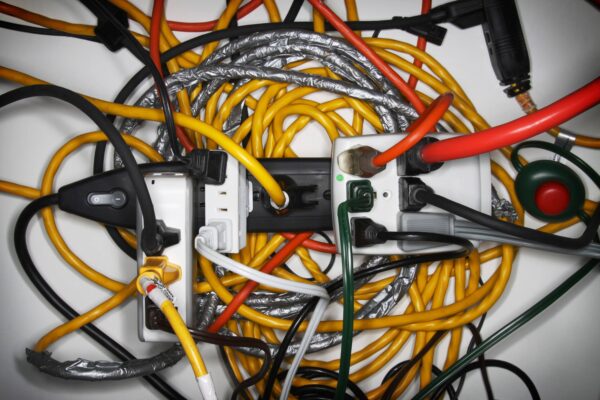Handling an electrical system can be risky. Improper use of electricity and electric appliances can result in severe damage, including death. It’s essential to utilize safety measures to protect the electric system to avoid electrical faults in buildings.
Circuit breakers are vital electrical devices that ensure safe use of electricity. They protect the electrical system and appliances from the dangers of short circuits and overloads. Circuit breakers are, therefore, critical components of an electrical system, from residential buildings to big commercial setups.
What Is a Circuit Breaker?
A circuit breaker is an electric device that acts as a switch to protect the electrical system and its appliances. You can operate a circuit breaker automatically or physically to avoid dangerous electrical fires and other risks related to electrical faults.
Circuit breakers mechanically detect electrical faults and interfere with an electric flow. In the case of a short circuit or an overload, a circuit breaker will automatically trip to stop the electric current flow. This helps to avoid overeating and the subsequent dangers that can trigger a fire outbreak.
Types of Circuit Breakers
There are various types of circuit breakers based on their applications. These devices are installed according to electrical-specific applications and potential electric faults. Besides, an electric system can present many unusual conditions that may wreak havoc. Therefore, choosing a circuit breaker device and its application is crucial in keeping the system safe. Additionally, circuit breakers are classified depending on their operating voltage levels, locations, and the existing electric system. These include:
- High-voltage circuit breakers for electric systems that carry 72kV AC and above
- Medium-voltage circuit breakers for electric systems ranging from 1000V to 2kV
- Low-voltage circuit breakers for power distribution systems of up to 1000V AC
- Miniature circuit breakers for electric systems less than 1000V AC
Molded-Case Circuit Breakers
Molded-case power circuit breakers fall under the low-voltage circuit breakers. These electrical devices have a case that supports their mechanical parts and is an insulation to the circuit breaker. MCCBs use thermal magnetic trips to cut off the power flow. They are commonly used in industrial, residential, and commercial electrical setups. In addition, these devices protect systems with currents flowing from 15 amps to approximately 1000 amps. Besides, you can reset the MCCBs for a determined operational duration without restarting them.
Insulated-Case Circuit Breakers
Unlike MCCBs, insulated-case circuit breakers are designed with higher short-circuit evaluations and use electronic OCPDs. Classified under the low-voltage breaker types, they have larger frames and more excellent amp ratings than MCCBs. Besides, the frames are made of plastic and constructed with draw-out or fixed-mount enclosures. They are used in low-voltage industrial power protection with a structural frame of 800 to 5000 amps. Also, they are a better choice for old air circuit breaker replacements.
Air Circuit Breakers
These types of breakers use pressurized air to function. When the breaker trips, the contacts separate and create an arc. ACBs remove this arc, maintaining a stable and secured current flow. An ACB breaker is ideal for industrial setups and protects overloads and short circuits for electrical systems between 800 amps and 10K amps. They are mainly used in low-voltage settings under 450V, such as small offices and houses.
Air-Blast Circuit Breakers
Air-blast circuit breakers use air-blast at higher pressures to eliminate an arc when the contacts open. ABCBs are among the oldest breaker types used in electric systems, with 345kV-550kV. The main challenge with ABCBs is coming into contact with moisture. Most electrical systems that used these breakers have phased them out for more efficient ones.
Gas Circuit Breakers
Gas circuit breakers (CB) mainly use sulfur hexafluoride (SF6) to interfere with arcs. As a high-density gas, the dielectric power surges as pressure rises. This gas is used in breakers ranging from 15kV to 65kV. These gas breakers have become a preferred choice to replace air-blast and oil circuit breakers.
Vacuum Circuit Breakers
A vacuum circuit breaker uses a vacuum to interfere with the flow of electric current in a system. When the contacts in a circuit breaker drift, an arc is formed and needs to be put off to stop the current flow entirely. The VCBs are designed with bottle vacuums that vaporize contact material to eliminate the arc. A single bottle of a VCB can interfere with a voltage of 15kV.
Further, VCBs are smaller and lighter in structure, making their maintenance costs cheaper. VCBs are fast, efficient, and excellent in medium and high-voltage electric systems.
Oil Circuit Breakers
Oil circuit breakers (OCB) use mineral oil as the quenching medium to interfere with the arcs. The breaker contacts are submerged in the oil when the circuit breaker is closed. In this case, the oil keeps the heat off and stops electric currents from flowing between the contacts. When you open the breaker, the contacts are disconnected and form an arc, which is extinguished by the oil.
Oil circuit breakers were previously utilized in high-voltage settings in power substations and huge power plants. But, OCBs are slowly becoming wiped out and replaced by more efficient and eco-friendly circuit breakers.
Miniature Circuit Breakers
A miniature circuit breaker (MCB) prevents electrical faults arising from extreme current flows in a system. MCBs act as an alternative fuse and are currently used in residential, commercial, and manufacturing electrical settings. With a breaking capacity of 10KA to 16 KA, MCBs have a smaller structural frame, making them a perfect choice for use in constricted areas.
Ground Fault Circuit Interrupters
Ground fault circuit interrupters are fitted in areas where electric current flows may unintentionally come into contact with water. These devices are commonly installed in laundry rooms, kitchens, bathrooms, or outdoor settings. A GFCI protects you from electrocution when your body comes into contact with electric currents and begins to receive a shock. Once the GFCI detects the shock, it cuts off the electric flow before you can get any further injuries.
Arc Fault Circuit Interrupter
The arc fault circuit interrupter is a circuit breaker that protects an electric system from arc faults that may cause a fire. The function of AFCIs is to detect the behaviors of an electric arc fault and interrupt the power flow before a fire erupts. Old or damaged and loose wires are among the primary causes of an arc fault at home. Therefore, AFCIs have become a standard installation in many modern homes, though they can still be installed in old homes in Apex as well.
Ask for Help From the Professionals
Electrical faults are common in homes today and can happen at any time of the day. Circuit breakers are vital electric components that help prevent these errors and keep off potential fire risks. You can now make an informed decision from the above types of circuit breakers and their applications. However, we recommend contacting a professional electrician at Thermo Direct for more information and advice.
Our company has been offering reliable electrical services to customers in Raleigh and the surrounding areas. Widely known for high-quality products and services, we take pride in our electricians, plumbers, and NATE-certified technicians for their expertise and upfront services. In addition, our business is certified by BBB, NCI, BPI, and Energy Star. Besides electrical services, we offer heating, cooling, plumbing, and air quality services.
Contact Thermo Direct today to book an appointment.









